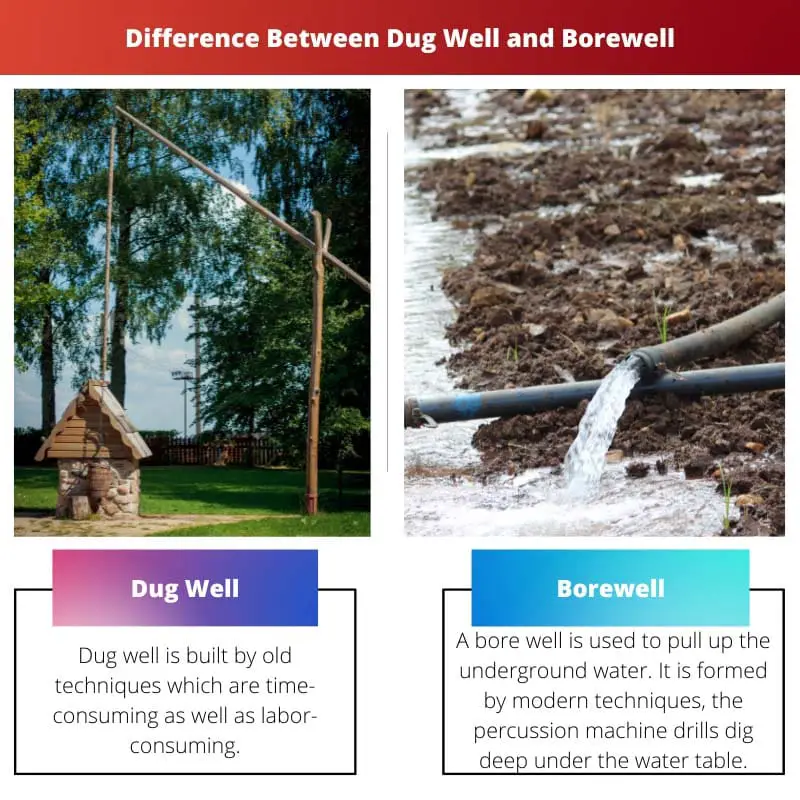Groundwater helped us way far in preventing water scarcity, and the use of dug wells and bore wells is still going on. These helped our population to fulfil the need for water.
Dug wells are formed by using a hand shovel and digging until it reaches the water level. And bore wells are built by rotator machines to dig deeper than dug well but with a smaller diameter.
Key Takeaways
- Dug wells are shallow, manually excavated wells with larger diameters.
- Borewells are deep, machine-drilled wells with smaller diameters.
- Borewells provide a more reliable water supply than dug wells.
Dug Well vs Borewell
Dug wells are shallow, with depths ranging from 10 to 30 feet. They are created by excavating a hole in the ground. Borewells are deeper wells ranging from 100 to 1,000 feet in depth. They are made by drilling a narrow gap into the ground using a drilling rig.

Dug well is built by old techniques, which are time-consuming as well as labour-consuming. It is done by hand shovel, which is difficult and risky.
In ancient times, people dused these dug wells to fulfil their water needs like washing clothes, bathing, and and even drinking. Nowadays, people use drilled wells in some villages for irrigation and other household activities.
A bore well is used to pull up the underground water. Modern techniques form it, the percussion machine drills dig deep under the water table to fulfil the requirements.
The diameter of the bore well is much smaller than the dug well. It pulls out the water with the help of a pump.
Borewells are 40-50 m in depth,, but if there are low chances of finding water,, it can be dug up to 45-55 m.
Comparison Table
| Parameters of Comparison | Dug Well | Borewell |
|---|---|---|
| Diameter | 1.2-1.5 meters | 4.5-6 inches |
| Depth | 20 meters | 40-50 meters |
| Tools Used | hand shovel | rotating drill |
| How to use | Buckets are used to take out the water. | The pump is used to suction the water and serve it with the help of a pipe. |
| Water capacity | It can reach below the water level, which means high water capacity. | It can reach below the water level which means high water capacity. |
What is Dug Well?
Dug well is an ancient technique to find and use water. It is 15-20 meters which only reaches the water level.
It brings contaminated water as used or dirty water thrown into the underground water, making whole water dirty and unable to use.
The water is brought out with the help of a bucket connected to the rope and pulled to uplift it. It consumes a lot of labour and time but is less expensive than a bore well.
Simple tools are used, and no skilled workers are needed. Dug wells are lined with stones, tiles, or bricks to prevent collapse.
A cap of wood covers it, and the land surface should be mounded around the well so that the water around it does not pond. If the dug well has a pump instead of a bucket,, it should be placed inside the house.
With low expenses and unskilled workers, dug well are the preferred choice for those villages.
During the construction of dug wells, many safety hazards can occur, like lack of oxygen, collapsing of sidewalls, and falling of any heavy object from above into the dug well while the presence of the workers.
So many precautions have to take place while building it.

What is Borewell?
Borewell is a modern technique to build a well to conserve water. It is 1700 feet deep and is is dug by the rotating drill machine under the ground level to create a space for filling the water between the rocks.
With the help of bear cracks under the ground, the water is collected and stored in the bore well.
We can store rainwater by making the surface flow towards the borewell by appropriate filtering. Electrical pumps are used to pump out the water. Nowadays, solar pumps are in use.
However, bore wells deplete the underground water and dry up if it is not closed. Hazardous miss can occur, like falling children into those holes if not completed.
The water collected by these bore wells is not drinkable as it is not filtered and hygienic. These wells are used in the irrigation process, etc.
The bore wells are connected to the pipe which supplies the suctioned water to the crops or is used in other household activities.
People living in rural places are slightly relaxed after having borne wells as it minimizes labour and hard work.
Whatever the bore wells provide advantages, and disadvantages should also be in mind like depleting underground water, water getting more contaminated, etc.

Main Differences Between Dug Well and Borewell
- The bore wells are more beneficial to form than dug wells as it requires less time and labour.
- Due to the depth of the dug well, the capacity of water is less than the bore well as it is just dug only to the surface of the water table but the bore well is dug below the water level.
- People with high population density in a village would prefer to bore well over dug well as it will feed more humans.
- The formation of both the wells is so different; the dug well is dug by hand shovel, whereas the bore well is dug by machine.
- No skilled workers are needed in dug well whereas bore well require professional workers.

- https://link.springer.com/article/10.1007/s10661-009-0848-2
- https://link.springer.com/article/10.1007/s12665-009-0342-8
- https://journals.sagepub.com/doi/abs/10.4137/EHI.S3149
- https://www.tandfonline.com/doi/abs/10.1080/03067319.2020.1800000

This article makes it clear that the choice between dug wells and borewells is not a simple one.
It’s clear that weighing the benefits and drawbacks of each method is vital in making decisions about water supply.
The importance of distinguishing between the differing techniques used in well construction is absolutely key.
I couldn’t agree more. It’s crucial to understand how these methods differ to ensure proper usage.
It’s outdated to rely on dug wells, we need to encourage borewell construction for better access to clean water.
The safety hazards during the construction of dug wells should not be overlooked, especially in developing areas.
The reliance on borewells and the hazards of misuse are important points to consider.
Absolutely, the environmental ramifications of increased borewell use are something to be aware of.
The references provided here make this article even more compelling.
This is exactly the kind of information we need before we make any decisions about our own water supplies.